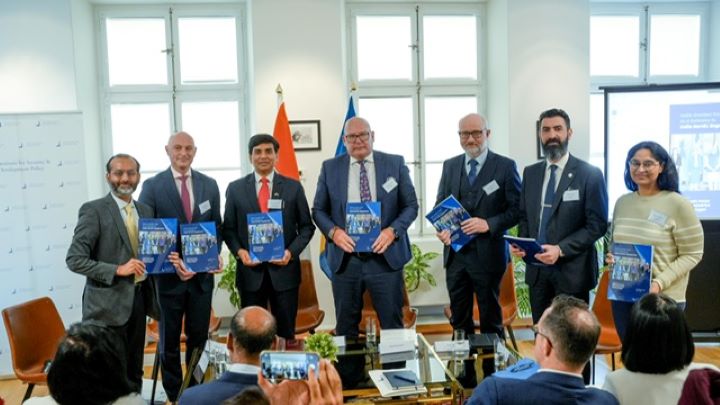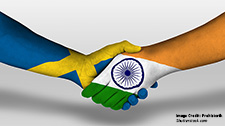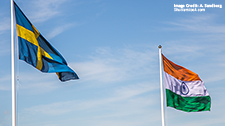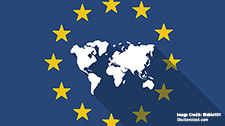India-Sweden Ties as a Gateway to India-Nordic Engagement

Jagannath Panda, Niklas Swanström, Mahima Duggal, Henrik Chetan Aspengren, Filip Borges Månsson, Pooja Bhatt, Henrik S. Werenskiold, Mats Engman, Giulia Saccone, Toby Logan, Mariya Krupach, Swasti Rao, Antonina Luszczykiewicz-Mendis, Eerishika Pankaj, Lena Bäcker, Janhavi Prasada, Olivier Blarel and Nicolas Blarel
Executive Summary
Sweden and India engage on three interconnected levels: bilaterally, through the Nordic region, and through the EU—all of which require consistent political attention and a structured strategic approach. Although there is political intent on both sides to enhance cooperation, the partnership between Sweden and India—similar to India’s ties with the Nordics and the EU—has faced challenges in realizing its full potential. To overcome this, both states need a focused joint agenda for action, encompassing key areas like ensuring resilience of supply and value chains; fostering future talent through cooperation for innovation and research; green transition; and defence and maritime collaboration.
Building a Strategic Partnership
• India’s partnership with the Nordic countries has strengthened as New Delhi increased its presence in Europe. One example of this is the India-European Free Trade Agreement (EFTA), of which Norway is a crucial member.
• Sweden stands out as a key partner for India, as the first Nordic country to publish an independent Indo-Pacific strategy in 2024. Moving forward, India’s engagement with the Nordics must focus on two key strategies: First, leveraging the Nordic states’ growing disillusionment with China to better align their strategic interests. Second, closing the ‘India gap’ in Sweden’s Indo-Pacific strategy by making the Indo-Pacific a point of discussion in their bilateral engagement.
• As Sweden and India seek to establish a more action-oriented partnership, the maritime domain presents the most pragmatic and practical avenue for engagement. Both countries share similar approaches in this domain and can capitalise on these opportunities to enhance collaboration.
• Key areas for action can include: maritime defence cooperation; maritime domain awareness and undersea domain awareness; resilient coastal and infrastructure development; marine scientific research and related academic/ capacity-building; shipbuilding, green shipping and port infrastructure development; and arctic cooperation.
• In considering India’s partnership with the Nordics, it is worthy to look the Nordic-Baltic Eight (NB8) grouping involving Denmark, Finland, Iceland, Norway, Sweden, Estonia, Latvia and Lithuania. The grouping has become increasingly active (most notably due to its strong stance on the Ukrainian issue) and represents a small but attractive and innovative market under the EU.
• The most notable indication of the potential of a partnership between India and the NB8 is the delegation’s participation in the Raisina dialogue in 2024 – the first such meeting for the delegation outside of Europe.
• Moving forward however, the current political and security situation could make collaboration on security issues more complicated. The NB8 has strong ideological commitments and has positioned itself as a staunch supporter of Ukraine’s sovereignty and territorial integrity. While the NB8 view this as an opportunity for India to present itself as a valuable, reliable partner, India’s position of proactive neutrality could make strategic collaboration more complex.
• Nevertheless, the NB8 is poised to be a critical player in European and Arctic security dynamics, and these regions will be immensely important for India’s global positioning. Delhi must recognise the NB8 as central players in its European strategy and look to expand issue-based collaborations, such as on maritime and polar research, Arctic governance, sustainable resource management and blue economy initiatives.
Related Publications
-
ISDP-Embassy of India in Sweden Dialogue Calls for Focusing Momentum in India-Sweden Ties
Focus on six key areas: Science & Technology, Innovation, Energy, Sustainable Development, Defense, and Trade Economics. The partnership between India and Sweden can be replicated as a model for the […]
-
India-Nordic Budding Dynamics: Sweden, a Vital Gateway?
The India-Nordic summits in 2018 and 2022 had the clearly outlined goal of the expanding strategic coordination between India and the Nordics. The spike in trade reflects a healthy economic […]
-
India-Sweden Strategic Compass: January-February 2025
The evolving geopolitical landscape, particularly marked by the U.S.-China rivalry, is indeed prompting nations to reassess their diplomatic strategies and realign their foreign policies. For countries like India and Sweden, […]
-
India-Sweden Ties: Forging a Cohesive Partnership
From areas like human rights and political differences to climate and sustainability, both countries often differ on certain points, sometimes causing friction in their bilateral relations. Most prominently, India and […]
-
Forecasting European Security in 2025: Will Transatlantic Ties Test Europe’s Indo-Pacific Limits?
In late December 2024, Finland—one of the latest entries to the North Atlantic Treaty Organization (NATO)—seized an oil tanker, with alleged links to Russia’s so-called “shadow fleet,” on grounds of […]




